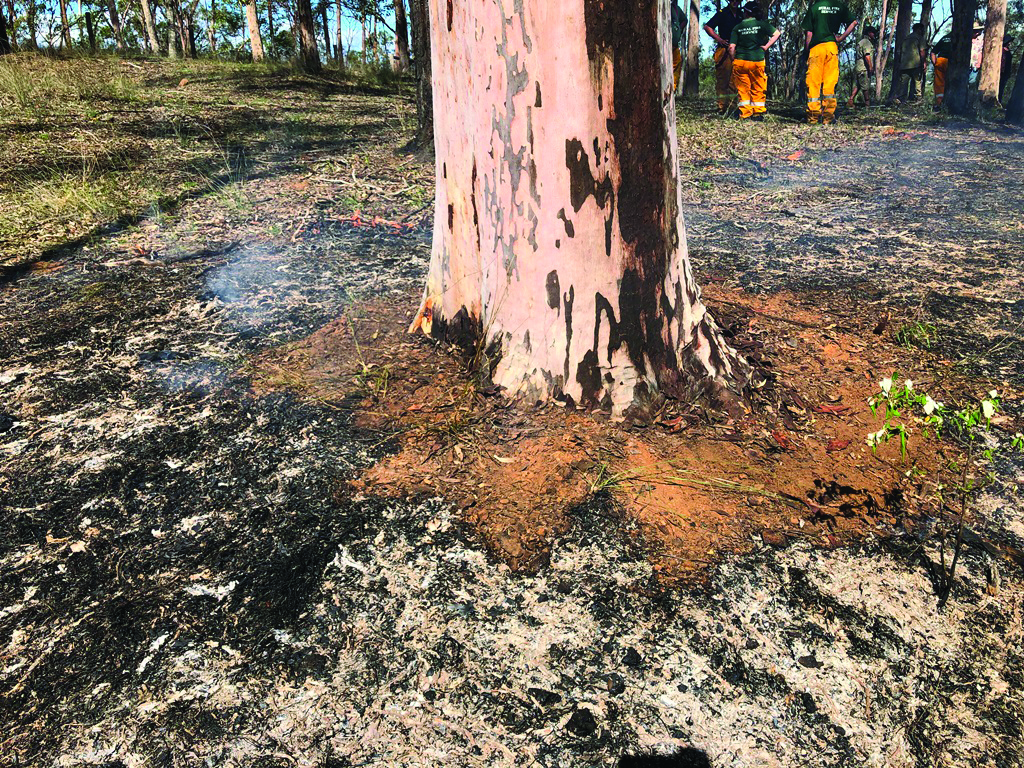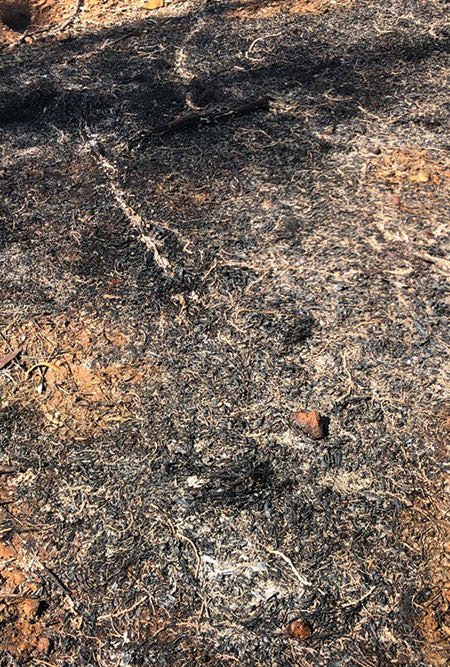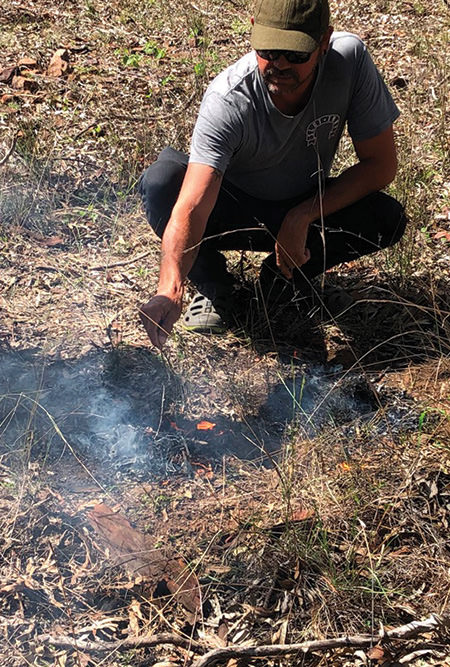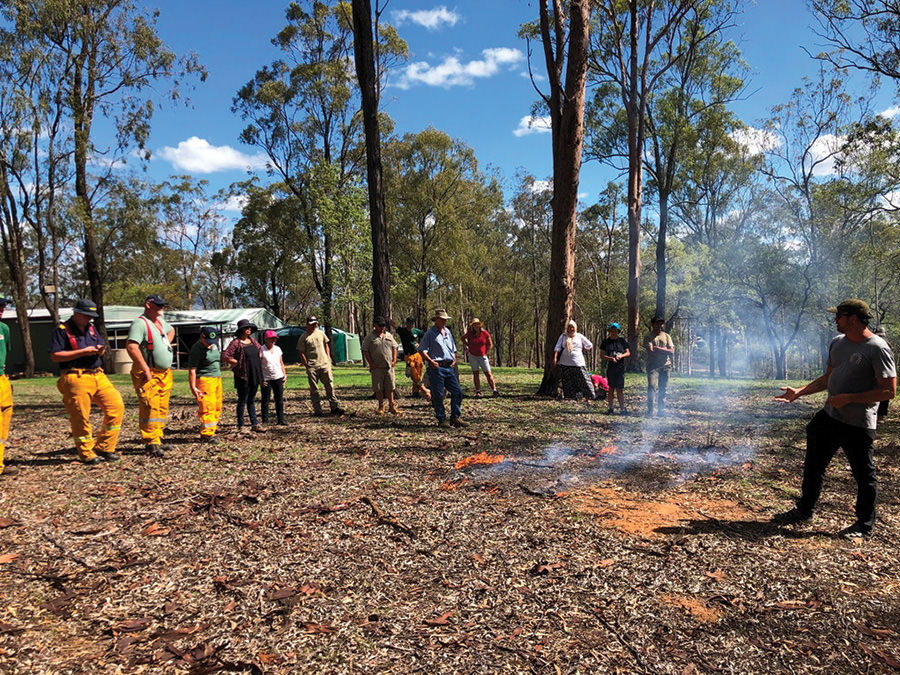I live on Yuggera/Ugarapul country in the Lockyer Valley. In April 2019 I hosted a Traditional Cultural Burning Workshop at my Land for Wildlife property in Grantham. This workshop was presented by Victor Steffensen, an Indigenous Cultural Fire Practitioner.
People from across SEQ including private landowners, members of the Queensland Fire and Emergency Services, members of rural fire brigades, the Bunya Peoples’ Aboriginal Rangers and government officials attended the workshop.
Because I have attended a number of these workshops previously, I have found that to understand the complexities and the simplicities of cultural burning all previous beliefs and opinions needed to be put aside. A fresh and open mind is required.
Firstly, Victor talked about the current situation regarding the politics of fire in the community, as well as mainstream methodologies and timeframes for burning. He explained how he started, was taught by his Elders and was given the task to teach younger Indigenous people so as not to lose the knowledge.
A fire should not be started without first knowing how to read the signs of the land. Traditionally this was done by fire practitioners.
Burning country was a spiritual event. With the first rise of smoke, a warning would be called to all the living creatures in the nearby vicinity. The instinct of wildlife is to crawl, slide or move away to a safe place. The cool burning fires did not burn away at the big trees so the insects and lizards had somewhere safe to go.




Once the fire was moving, the young people were then left to walk with the fire. This was an opportunity to yarn while keeping an eye on the fire. They were not constricted by a timeframe. Community played a big part in fire for Indigenous people and so it should for us today.
Victor explained the different curing times (when the land is ready), depending on the tree species present, and the corresponding months desirable to burn those areas. Too much leaf litter restricted the growth of grasses, herbs and shrubs. Fires that are too hot dry out the ground below the surface killing all the microorganisms.
He pointed out that all country is not burnt, such as deep gullies and rainforest areas. Some areas are bush food country, and some are bush medicine country and these factors are also taken into account.
Nowadays we have an altered landscape for a variety of reasons including the introduction of exotic plant species, past land uses, the wrong fires and invasive native plants. The task for us, Victor pointed out, is to heal the country.
Depending on the site, the healing process will differ. There is no one size fits all. These healing processes could vary from more regular burning every year or removing the weed species first before burning.
Victor explained there were no set time frames for burning different ecological communities. That is, no five to seven-year periods or twenty to thirty-year intervals as often advised. It was all about the knowledge to read the country correctly, and with that knowledge comes safety. Thanks to Victor for passing on his knowledge.
Article by
Sally Jenyns
Land for Wildlife member
Grantham, Lockyer Valley

The current standard practices of wide scale hot “hazard reduction” burns and use of chemical fire retardants are controlled actions that must be changed and quickly. So too the forest practices that squander native forest resources for wood pulp. These practices create more fire hazards, destroy more species and habitats, and prevent rather than enable forest ecosystems and biodiversity to recover and thrive over time. The work of Victor Steffenson [Fighting Fire with Fire Australian Story April 2020] to share and grow respect for traditional aboriginal fire laws and knowledge of country, is so very important for the future of biodiversity and ecological sustainability of Australia’s cultural and natural heritage. Training courses and programs based on this methodology should be promulgated nationwide.To regrow and sustainably manage our natural landscapes more plantation timbers must be planted; and we must add to the toolkits for bushfire hazard management and biodiversity conservation, traditional aboriginal cool burn fire practices, contemporary local area knowledge and state of the art ecological science.
We have a farm in the Sunshine Coast hinterland and would like some advice on Cultural burning. Can you provide any contacts please?
We watched the program on Victor Steffensen on the ABC.
Thank you
Thanks for your question. We have sent you an email.
Also, there are three websites listed in the original article that are not shown in this blog – they are:
http://www.firesticks.org.au
http://www.livingknowledgeplace.com.au
http://www.mulong.com.au
Hi we also have property in the sunshine coast hinterland which we believe hasn’t been burnt off for 10 plus years. Any information would be fantastic.
Cheers
I am trying to source a cultural burn on the Sunshine Coast. When we first moved here we were the only LFW property between two small farms. Just found out yesterday that both neighbours are now LFW. Hoping to be able to maybe get together – haven’t spoken to the others as yet – and have a cool burn. About 12 years ago there was one burn – hot, fast and devastating and not to be repeated if possible. The one property has not had a burn since we came her – 21years ago. There has been an increase in fauna and flora since we started our planting all those years ago but it needs renewing